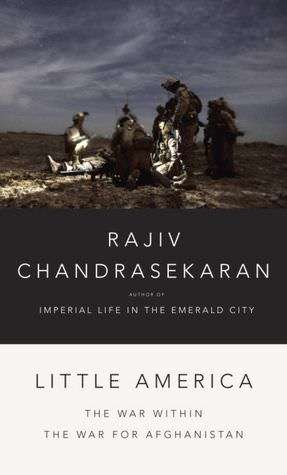Losing the War in Afghanistan
War is hell, and so is bureaucracy.
Little America: The War Within the War for Afghanistan, by Rajiv Chandrasekaran, Alfred P. Knopf, 333 page, $27.95
America's longest war began on October 7, 2001, when U.S. special forces entered Afghanistan to help topple the Taliban regime. That mission was accomplished in weeks, not months. With heavy backing from the United States, Hamid Karzai emerged as the head of a nascent government in the long-war-torn country.
But Little America, a compelling new account of the Afghan war by Washington Post correspondent Rajiv Chandrasekaran, begins earlier. Chandrasekaran traces America's involvement in Afghanistan back more than half a century, starting with an Afghan king's plans for a development project in 1950 and continuing through the American presence there today.
When President Barack Obama announced a military surge in Afghanistan in 2009, Secretary of State Hillary Clinton added that a "civilian surge" would be a necessary part of the package. But the new spending turned out to be as ineffective as the Afghan government itself. Chandrasekaran, who came to Afghanistan in 2009 to cover the war for the Post, describes several sprawling facilities for Americans and other Westerners in Kabul, replete with amenities to emulate a modern Western campus and divorced completely from the world on the other side of the walls and fences. Stores offered overpriced souvenirs for Westerners stationed in Afghanistan who wanted something to prove they'd been there. Some offices had Virginia phone numbers, as if the State Department bureaucrats had never left home.
Chandrasekaran meets one employee recruited directly by Richard Holbrooke, Obama's special representative for Afghanistan and Pakistan, after he was appointed in January 2009. Summer Coish had spent years in the region running a bimonthly periodical out of Kazakhstan. She was declared a security threat while being processed for government employment because she had opened a foreign bank account, used for the magazine. When she finally got to Afghanistan she found she couldn't get much done. "It's rare that you ever hear someone say they're here because they want to help the Afghans," she told Chandrasekaran. Coish divides most of the employees in the compound into "three camps": those trying to collect a hefty paycheck, those fulfilling a prerequisite for cushier postings, and those running away from problems in America.

Chandrasekaran tells plenty of stories about petty bureaucratic behavior in those compounds. There's the tale of an official emailing his subordinates to admonish them about the proper use of I and me. ("NEVER, NEVER, NEVER SAY: 'He told Andrew and I.' SAY: 'He told and Andrew and me.' If he told me, he didn't tell I.") There's the tale of a female embassy worker urinated on a patch of grass near a flagpole during a drunken party, then threatened to sue the State Department under the Americans with Disabilities Act if it disciplined her. Such stories would be funny if they weren't happening in the midst of a bloody and costly war.
Again and again, Chandrasekaran suggests the Americans' most formidable enemy is not the Taliban but bureaucratic infighting. These counterproductive squabbles are best illustrated by the experience of Holbrooke, the special representative for Afghanistan and Pakistan. Chandrasekaran makes a reasonable case that the 2009–2010 surge created a prime opportunity for negotiations, as U.S. forces were able to clear insurgents from areas previously ignored by NATO allies. But Holbrooke insisted on approving nonmilitary initiatives in both Afghanistan and Pakistan while running a disorganized staff, with his own paperwork constantly piling up. He also aggravated his colleagues by calling them in the middle of the night to talk shop and by always being the center of attention for journalists. All this, in turn, prompted many officials to spend more time trying to squeeze him out than trying to take political advantage of the temporarily favorable conditions. Only when Holbrooke died in December 2010 did the work toward reconciliation negotiations begin in earnest, and by that the time the opportunity had been squandered. But at least Holbrooke wouldn't get any credit.
By Chandrasekaran's account, the U.S. forces on the ground accomplish the tasks they're given, but there's no clear mission in Afghanistan and no direction from the top. And no one has figured out a way to deal with an even more fundamental problem: the weak, corrupt, and hapless Afghan government. Under both Obama and his predecessor, White House policy on Afghanistan has relied on there being a reasonably effective national government in Kabul, and that institution does not exist. President George W. Bush started biweekly teleconferences with Karzai in 2006; during the presidential transition, Chandrasekaran reports, the Obama administration concluded that Bush "had become the case officer for Afghanistan." The new White House took a tougher stand on Karzai—denying him, for example, direct access to President Obama—but there could be no war in Afghanistan without a government there to legitimize it, and Karzai provided one. But he didn't, couldn't, and probably can't provide the infrastructure on which the American nation-building project is predicated. That isn't likely to change even if U.S. troops stay til 2022.


Show Comments (54)